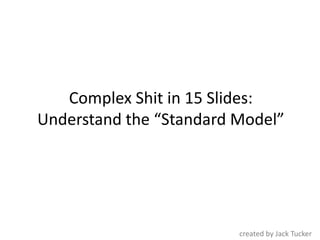
Standard model presentation
- 1. Complex Shit in 15 Slides: Understand the “Standard Model” created by Jack Tucker
- 2. **This is an extremely high-level picture** • The model attempts to easily explain how the fundamental particles interact with each other • Go through the slides consecutively. Use “click me” notices or underlined hyperlinks to quickly jump to a specific slide for a particle or force • The model in the top-left is to help show which “level” of the atom is being discussed. All particles within it are click-able
- 3. Simple Atom End Presentation (Hydrogen-2 Isotope; Deuterium) Electron (Click-able) Nucleus Click- able Orbital: Not able to know exact position and momentum of an electron. Until observed, the electron is in all places within the orbital at the same time. (Heisenberg Uncertainty Principal)
- 4. End Presentation Inside the Nucleus Neutron (Click-able Items) ~ + Proton [Back to Beginning]
- 5. End Presentation ELECTRON Member of the “Fermion” family, but really is a “Lepton” (Click-able Items) e- Has a negative charge; no known components [Back to Beginning]
- 6. End Presentation Inside the Proton ~ Baryon + (Click-able Items) Up Fermions, A.K.A. Quarks Down Up [Back to Beginning]
- 7. End Presentation Inside the Neutron ~ Baryon + (Click-able Items) Up Fermions, A.K.A. Quarks Down Down [Back to Beginning]
- 8. End Presentation Fermions (The “matter” Particles) ~ Two Types + (Click-able Items) These two groups interact with each other using the ‘force carriers’ to form the matter we can see and touch Leptons Quarks Part of Quark: Generation Part of Up 1 Lepton: Generation Down 1 Electron (-) 1 Force Carriers Charm 2 Muon (-) 2 3 Strange 2 Tau (-) Top 3 Bottom 3 Theorized force and particle interactions [Back to Beginning]
- 9. End Presentation Force Carriers (Gives ‘force’ to the interactions between fermions) ~ A way to think about this is that fermions + (leptons and quarks) “exchange” the (Click-able Items) particles below, resulting in the correct force, creating what we can see and touch. Force Name Mediated/"Carried", by How used? Electromagnetism Photons electromagnetic spectrum Weak Force W+, W-, Z Bosons formation of chemical elements holds protons, neutrons in the Strong Force Gluons nucleus Gravity graviton? Gravity, general relativity Theorized force and particle interactions [Back to Beginning]
- 10. End Presentation Quarks ~ + • Quark types are known as “flavors” (Click-able Items) •(Up, Down, Top, Bottom, Charm, Strange) • A grouping is a “hadron”. A hadron of 3 quarks is a “baryon” Quark: •So, protons and neutrons are baryons. Up • Quarks are never found in isolation, only grouped together (hadron) Down Decreasing Mass Charm • Quarks are the only elementary particles that experience all of the force carriers (electromagnetism, weak, strong, gravitational) Strange Top • All “normal” matter consists of Up and Down quarks Bottom Could Charm/Strange & Top/Bottom combine to make a heavier version of a proton and neutron? [Back to Beginning]
- 11. End Presentation Leptons ~ Electron: has a negative charge; no known components; + the natural ‘populator’ of atomic orbitals (Click-able Items) Muon: Identical in every way to an electron except it’s heavier; Lepton: decays into electron quickly; Decreasing Mass Able to replace electrons in atoms (Muonic Atom)! Electron (-) -Due to larger mass, atom would be smaller than normal Muon (-) Tau (-) Tau: Also identical to an electron except it’s even heavier; decays into electron quickly; Able to replace electrons and muons in atoms (in theory) Neutrino Particles: Not depicted in the presentation. Identical to their counterpart (electron, muon, tau) but without any electrical charge. (Easily confused with neutron) Muon’s and Tau’s beg the question of why are there heavier copies of electrons? Additional Questions [Back to Beginning]
- 12. End Presentation Higgs Boson ~ + (Click-able Items) • Has not yet been observed. The Large Hadron Collider (LHC) was constructed to attempt to find this particle. (They’re getting really close) • Can hopefully explain why particles have mass. i.e. Why the photon and gluon have no mass and the W and Z bosons are incredibly massive. • By understanding why force particles have mass, we can better understand the how matter is formed. Theorized force and particle interactions [Back to Beginning]
- 13. End Presentation Graviton ~ + (Click-able Items) • Not a recognized force carrier within the standard model, yet. But we know something needs to account for gravity. • We know ‘general relativity’ (i.e. faster you go, slower time goes) is true because we see the results of it each day (used in GPS). It is attributed to gravity which affects space-time but we have no way of pointing to a specific force carrier that exhibits those traits like we can with all other phenomenon Theorized force and particle interactions [Back to Beginning]
- 14. End Presentation Final Questions ~ + (Click-able Items) • If all normal matter is made from electrons and up/down quarks, part of generation 1. Could you make an entire new set of matter from generation 2 and 3? After all, those particles are identical to generation 1, just heavier. • Could there be other universes where the muon and tau particles are normally used in the atom rather than the electron? [Back to Beginning]
- 15. What now? 1. “Like” or comment on this post: 2. Save this link: www.ubiquitousnowhere.wordpress.com 3. Tell your friends 4. Check back later for more “Complex Shit in 15 Slides or Less”!
